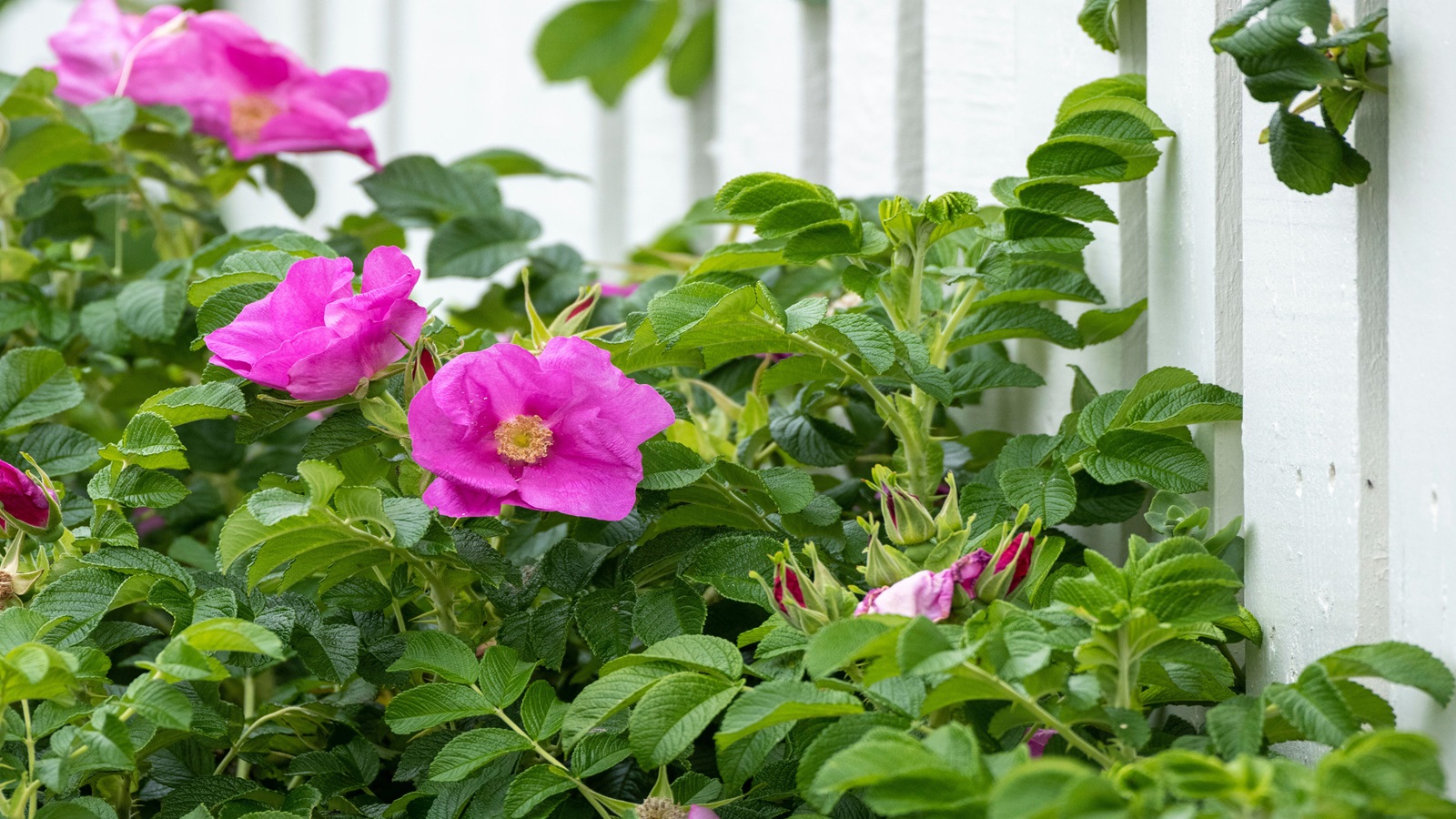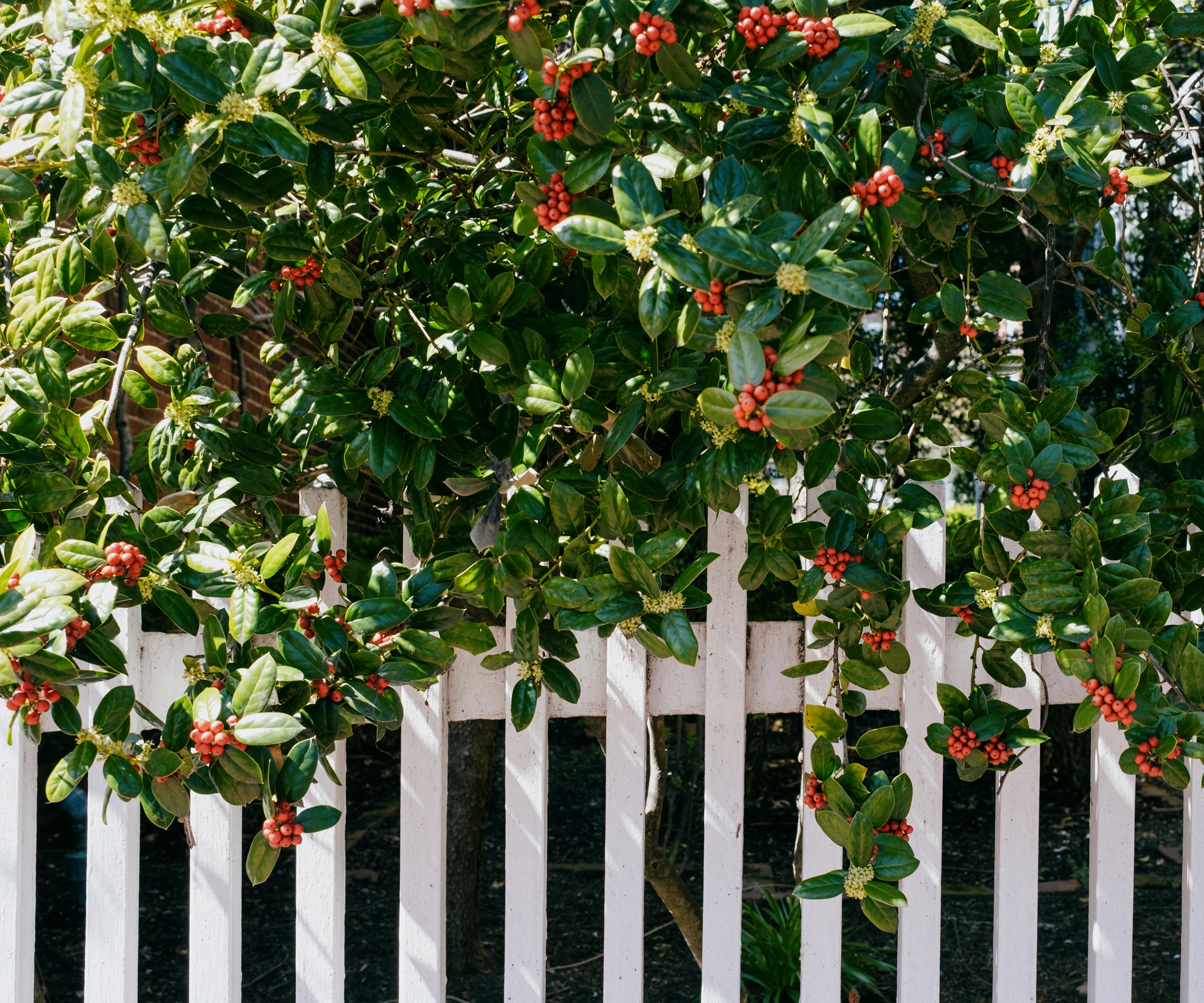Intruder proof hedge plants – 10 plants to boost home security
Discover the hedging options that will make your home more secure


Intruder proof hedges are a fantastic way to add an extra layer of home security. Laden with thorny stems and dense foliage, they act as an effective deterrent to unwanted visitors, but there is more to these plants than just their spiky personas.
Many of these flowering hedge plants provide valuable shelter and nesting sites for birds and wildlife, maturing into important mini ecosystems and forming a network of wildlife corridors in urban neighbourhoods.
There’s also the seasonal spectacle of the sheer concentration of blooms and vivid fruits condensed into hedge form. A row of hawthorn plants in full bloom or berry-lade firethorn are both spectacular garden features. Easily clipped to keep them in check, they are also among the best privacy hedges you can grow.

10 of the best intruder proof hedge plants
Whatever your home style, location or climate, there are dense and thorny hedging plants to suit. From hardy natives to more flamboyant varieties, these are some of the best plants with thorns and spines, and some of the best ways to plant for home security.
1. Firethorn

Pyracantha is a stunning choice for a creating a prickly barrier around your home. ‘This evergreen shrub offers a combination of thorny protection and vibrant berries, adding aesthetic appeal,’ says landscape designer Jonathan Ames.
Native to south east Europe and south-west Asia it bears a mass of cream colored blooms in summer followed by clusters of dense orange, red berries in fall. These fruits are popular with birds and small mammals making them one of the best hedges for wildlife.
Suited to growing in USDA hardiness zones 6-9, there are many standout varieties to choose. These include strong -growing pyracantha ‘Orange Glow’ and Pyracantha rogersiana 'Flava' with its arching stems and vivid yellow berries. Fast growing Pyracantha ‘Mohave’ is available at Walmart.
Design expertise in your inbox – from inspiring decorating ideas and beautiful celebrity homes to practical gardening advice and shopping round-ups.
Timing is key when it comes to planting pyracantha, Jonathan explains, ‘The best time to plant these hedges is in early spring or late fall in a sunny to partially shaded location with well-draining soil.’
2. Shrub rose

Fancy a floriferous, fragrant but intruder proof hedge surrounding your yard? Then good old fashioned roses are hard to beat. One of the best hedging plants around, space them around 18 inches (45cm) apart and their thorn-laden stems will gradually form a dense hedge reaching heights up to 6ft (1.82m) if you let them.
David Austin's English roses are well suited to growing as hedges, along with more compact Gallicas, Albas and modern shrub roses - such as Olivia Rose Austin and Roald Dahl.
Flowering repeatedly through the summer months, they have been bred for color, perfume and disease resistance. Learn when to prune and fertilize roses and you can enjoy an abundant floral boundary around your home. Walmart stock a selection of David Austin shrub roses.
3. Blackthorn

For a barbed hedge that is slightly on the wild-side, Blackthorn or prunus spinosa is an excellent choice. A small, deciduous tree it produces tiny white flowers in early spring followed by dark green, oval leaves. A rich nectar source, its blooms are loved by bees and other pollinators, while the young foliage provides food for the caterpillars of many species of moth.
One of the best fast growing hedges, reaching up to 13ft (4m) tall, these sturdy plants are also long-lived taking up to fifty years to mature. The foliage turns a showy orange in fall before dropping, exposing the dense mass of sturdy branches and their needle-like thorns.
Tolerant of a wide range of soil types and conditions, this plant will thrive in USDA zones 4-8.
4. Barberry

There are over 400 species of Berberis or barberry to choose from. Shade and drought tolerant, these deciduous or evergreen shrubs pair mainly red or purple foliage with super sharp spikes along their branches.
Growing up to 10 ft (3m) tall, these plants make a formidable but attractive hedge, that’s also popular with bird and wildlife, thanks to the yellow nectar rich blooms in spring and juicy berries early fall.
Berberis thunbergia, the Japanese barberry has brilliant red deciduous foliage. Growing to around (1m) tall, new green growth appears in spring and turns a vivid scarlet August to October.
For a fast growing but shorter hedge, consider Berberis thunbergia ‘Crimson Pygmy’ or 'Crimson Beauty' Barberry - available at Nature Hills. With deep burgundy leaves from summer to fall, it’s a striking shrub that quickly knits together to form a dense hedge. The dark stems are covered with sharp spines and only reach a height of 2 ft (60cm), so perfect for pairing with a taller fence, thorny climber or prickle laden window box.
5. White stemmed bramble

Looking for a thorny hedge with a difference, then Rubrus cockburnianus or the white stemmed bramble is a dramatic choice. Ok, it does need a fair amount of space, but keep it in check and this plant will reward by producing long arcing stems blushed with a ghostly white bloom.
A striking sight in a winter garden, deciduous varieties drop their lime green leaves to reveal a mass of tangled stems covered in sharp bristles or thorns.
Best grown in a sunny or part shady spot, this plant will reach 5 x 5ft (1.5 x 1.5m), making it most suitable for rural or spacious plots.
6. Hawthorn

‘A dense, fast-growing hedge with thorny branches, hawthorn provides an excellent barrier,’ says Jonathan Ames. Native to north America, Europe and Asia, they thrive in USDA zones 4-8, on a range of different soil types and can happily cope with exposed conditions and urban pollution.
A magnet for insects, these tough, thorny shrubs are covered with small, white or pink tinged open blooms in early spring set against intricately cut dark green foliage. Red or orange berries appear in fall and remain on the branches well into winter. Often found in ancient mixed species hedgerows, hawthorn hedges offer valuable shelter, food and nesting sites for birds and wildlife.
Expect hawthorn to reach heights of 10ft (3m) if left untrimmed but they can be pruned annually to keep them in check.

Jonathan is a garden and landscaping expert, with expertise in garden design. He works for BACQYARD, with a team of dedicated landscape architects seeking to revolutionize the way we interact with our outdoor spaces.
7. English holly

A festive favorite, common holly or Ilex aquifolium is a great choice for training into a dense, imposing hedge that will deter intruders. Although it can take time for young plants to mature, this shrub will knit together to create an impenetrable boundary.
‘Holly has prickly foliage that is irritating to the skin, which will help prevent unwelcome guests from getting too close to your home,’ says New York-based landscape designer Amber Freda. ‘Partial to full sun, hollies do best in slightly acidic soil.’ For a spectacular show of berries try Blue Princess Holly available at Nature Hills.
Reaching 13-26ft (4-8m) wide and over 39ft (12m) tall these hardy plants can be grown as fantastic evergreen trees, but by clipping them into neat lines you can create crisp, formal boundaries.
Amber suggests, ‘An electric hedging shear is a great tool to help shape the plants into a neat looking hedge and effective privacy barrier for your home.’
Amber Freda offers design and installation of roof gardens, terraces, backyards, patios, and decks, primarily in Manhattan, Brooklyn, and Queens. Amber has taught more than a dozen classes in horticulture at both the New York and Brooklyn botanical gardens.
8. Flowering quince

Hardy down to temperatures of -25 F (-3.8C), Chaenomeles speciosa is a spectacular sight in full bloom. Trained against a wall or grown as a shrub or hedge, it’s a robust plant with a mass of tangled spiny branches.
The cup-shaped flowers, in shades of white, orange, red or pink, appear in early spring and look particularly stunning set against the bare, smooth grey branches. Attractive to hummingbirds and other pollinators, these blooms are then followed by glossy green deciduous leaves.
Besides keeping intruders at bay, these sun loving shrubs are one of a few deer resistant plants. They are, frustratingly, rather irresistible to rabbits, so not ideal for edging crops or a veg patch.
9. Juniper

Juniper makes a stunning hedge, that looks crisp and formal when closely clipped. Tactile with aromatic, silvery green foliage, these coniferous plants thrive in USDA zones 2-10. There are many different types of juniper, when it comes to hedging it's important to avoid the ground cover varieties.
‘Junipers make effective boundary hedges,’ says landscape designer Amber Freda. ‘They have prickly foliage that is irritating to the skin, which will help prevent unwelcome guests from getting too close to your home.’
Female juniper plants produce tiny, insignificant flowers between the leaves from June onwards. These are then followed by the distinctive blue-black berry-like fruit. Decorative and a great food source for both birds and mammals, they also have medicinal uses and can be used to flavor red meats, game and gin.
Tough and attractive, these conifers are easy-going once established. ‘Junipers are somewhat drought-tolerant and can tolerate anything from mild acidity to alkaline soil,’ continues Amber.
‘Depending on the size of the plants and how close you plant them, it may take some time for the plants to form a really dense hedge. An electric hedging shear is a great tool to help shape the plants into a neat looking hedge and effective privacy barrier for your home.’
10. Sea Buckthorn

Instantly recognised for its sharp spines and vivid orange berries in fall, Sea Buckthorn or Hippophae rhamnoides is an ornamental, deciduous shrub that’s found in coastal areas. Covered in fine silver-green leaves, it will happily thrive in exposed, salt-laden climates and poor soil conditions.
Tolerant of cold temperatures, this popular hedging plant will grow in USDA zones 3-8 and reach a height and spread of 8-12ft (2.4- 3.6m). Though all plants produce tiny flowers and catkins in spring, only female plants will bear fruit in fall.
These brilliant orange fruits look spectacular appearing in clusters on the branches where they remain for weeks, making them one of the best shrubs with winter berries. Packed with vitamins A,C and E they are widely used to flavor jams, tarts and jellies and can be juiced.
FAQs
How often should you water a newly planted hedge?
Any newly planted hedge will need its roots watering once or twice a week depending on the weather, the soil and the chosen species. Once the roots have had a chance to establish watering should only be necessary in extremely dry conditions. Mulching underneath the hedge will help to conserve water and prevent roots from drying out.
Planting an intruder proof hedge can upgrade your home's curb appeal and security system, as well as raising your yard's biodiversity. Why not investigate other ways you can plant for home security and handy tips to prevent porch pirates.

Journalist Jill Morgan has spent over 20 years writing and editing gardening, interior and property features. Titles she has worked on include The English Home, House Beautiful, Ideal Home, Houzz and Modern Gardens and she writes regularly for H&G as a Contributing Editor. Whilst she is a dab hand at renovation projects and DIY, she is happiest when out digging in the garden or planning a new border.